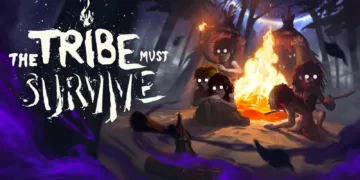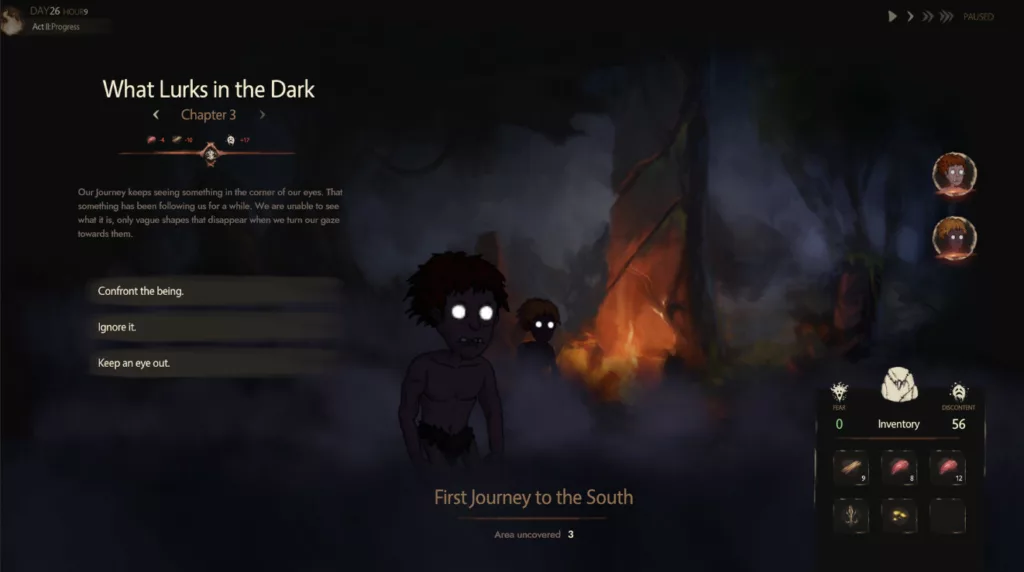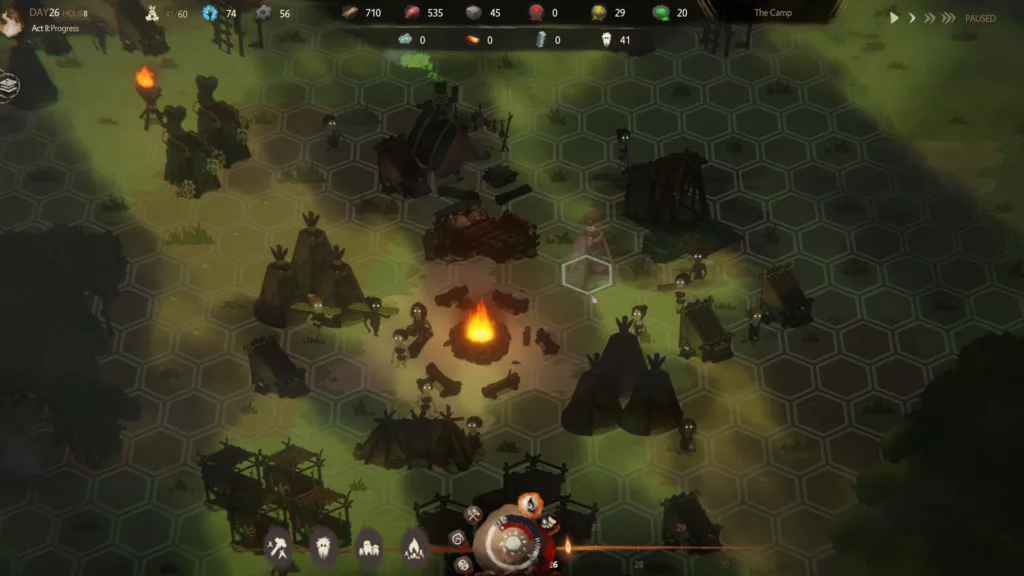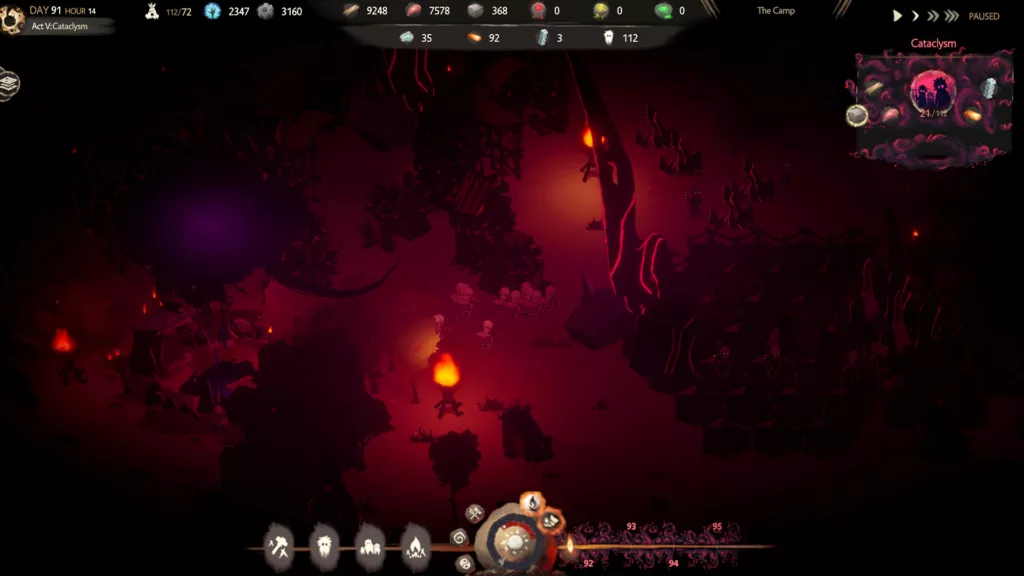The shadows creep close as night falls upon the tiny tribal settlement. A few flickering fires cast dancing shadows between the crude shelters of twig and daub, where exhausted villagers huddle for warmth and protection from the darkness beyond.
There, at the fireside, the newly appointed village head must make urgent decisions to guide their people through the night. Resources are scarce after a long day of foraging, bellies remain unfilled, and tempers are short. Fear and unrest spread like a chill as the flame began to sputter and gutter in the growing gloom. Swift choices are needed to steady hands and hearts before the darkness overwhelms them all.
From these tense beginnings, the challenge of The Tribe Must Survive emerges. Players step into the worn mudprints of a tribal leader tasked with shepherding their people through mysterious hardships. Each twilight brings new threats lurking at the edges of the firelight, from hostile forces abroad to inner troubles swelling within the heart of the community.
Only through deft management of resources, relationships, and rituals can this fledgling tribe find a fragile footing to endure another dawn. Their survival will require balancing competing needs amid the balance of shadow and flame.
Building Community and Connection
Leading a tribe in The Tribe Must Survive requires juggling a delicate balancing act. As village heads, players are tasked with overseeing everything from resource gathering to rituals. The well-being of each individual villager and the community as a whole depends on making careful choices and prioritizing needs.
A core part of the challenge involves resource management. Players must ensure their people are fed, rested, and their fears kept in check. Food stores, wood supplies, and other basics like stone and fiber must be steadily collected while also expanding outward. Villagers spend their days foraging, but players must build shelters and stockpiles to support growing numbers.
Technological progress plays a role as well. Advancing along research trees unlocks improved tools, defenses against threats, and expanded abilities. Yet each milestone requires precious resources better used elsewhere in the tribe’s early stages. Careful planning is needed to balance progress.
Villagers themselves also influence the path forward. Different factions emerge focused on philosophies like improvement or control. By addressing needs and resolving conflicts, players can encourage one mindset over others. This shapes future development.
Spiritual aspects offer additional boons but come at a cost. Complex rituals allow healing or sharing spiritual visions yet require significant preparation and participation. Players must consider if beliefs have taken root enough to make rituals worthwhile.
Everpresent darkness also challenges the tribe, as do periodic disasters. Fears rise when night falls and work ends, so light and protection take priority. Events like eclipses further test community bonds and players’ ability to lead through hardship. Only by opening lines of communication between all can a tribe hope to weather these threats together.
Progress demands facing threats openly while meeting personal needs. The Tribe Must Survive captures not just structures but also the human connections that transform a group of individuals into a community working as one. Strategic thinking, careful listening, and bringing disparate parts together are the true keys to survival.
Shadows of the Forest
In The Tribe Must Survive, an unsettling air hangs heavy in every misty woodland. Players lead a tribe amid an atmosphere shrouded in cosmic dread. Lovecraftian influences infuse each moment with a sense that something sinister lurks beyond the fire’s glow.
You guide villagers through an ancient tribal existence, carving shelter from dense forest. Creaking trees tower ominously, their grasping branches obscured by the shadows’ veil. As daylight flees, an eerie nocturnal chorus arises—what unseen beasts howl in darkness? Your people find solace near fires yet still fear what night may bring.
Developers crafted an aural tapestry to enhance the setting. Foreboding strings and subtle woodland noises immerse one in the woods. Yet unease grows as an otherworldly drone swells, insinuating nameless terrors that stalk beyond senses. Visuals balance allure and austerity, as if beauty yet harbors bleakness. Villagers themselves remain merely silhouettes; personalities are felt more than seen.
Players thrive where the forest rules, confined within nature’s bounds. Resources flow from the woods yet remain scarce. Progress means carving a livelihood from this primeval place. Shelters advance from simple huts to clustered encampments, yet woods ever remain, mysterious in the moonlight’s wane. Civilization stems from connections to the wild, whose threats must constantly be weathered.
In The Tribe Must Survive, one accepts leadership not over a landscape but within it, forever at the whims of the woodland’s watchful waves. Shadows foster suspicion of what may emerge should the lights fade. Still, there is solace in community—and in combating the dark through defiant bonds of unity.
Trials in the Forest
Leading your tribe in The Tribe Must Survive brings no shortage of challenges. From sinister specters lurking beyond campfires to upheavals that threaten all progress, each choice carries weight. While the village crafting aspects feel engrossing, true tests arise from survival’s struggles.
Resources here exist to be strained, with shortages developing quickly. Wood and food demand constant fetching, yet villagers prove scarce. Their wellbeing too hangs by threads; keep fear or unrest stirred for long; disorders may inspire riots’s ruin. Careful tending of moods and spiritual resolve must balance work’s demands.
When disaster strikes, little remains forgiving. Eclipses smother the world in darkness for days, stripping work to forage alone. Floods ravage shelters and stockpiles with fury. Creatures drawn by such tumults care not if villagers cower defenseless. Rebuilding after each onslaught demands scarce materials once more.
To expand, players push risks further. Opening outposts costs dearly in manpower village growth, which scarcely replenishes. Exploration risks not only supplies but also lives in the lurking shadows’ grasp. Gaining footholds further afield tightens the strain on already-thin resources.
Such a hard way of life proves no small hurdle for the uninitiated. Learning the nuances of villager rapport and progress’s pace requires stumbles and mistakes to be made. Only through failure does one grasp what escalates fear’s tides or starves the tribe when it is least affordable. Progress here demands not just planning but patience in solving problems.
The Tribe Must Survive relishes rewards found beyond the simplest comforts. Here rule brings not privilege but purpose—the fulfillment of guiding lives through perils that offer no leniency and seeing civilization flower against each darkness’s swell. Its challenges demand no mettle be spared.
Continuing the Journey
Games often lose their shine after beating all challenges. Not so with The Tribe Must Survive; each return finds fresh problems. New lands birth with each play, resources scattered amidst ever-changing terrain. Familiar gameplay proceeds down diverse paths.
Rewards emerge, too, for those who dive again and again. Perks become purchasable, and upgrades augment old strategies. Deeper crafting techniques give us tools to shape the world differently. Late stages unveil as milestones pass, but surviving them demands fresh insight.
Achievements invite experimenting further. Challenging oneself with stricter rules offers new stories of survival. Modes catering to risk or history immortalize heroic tales. Their rewards spur replays, chasing each feat.
Potential remains open-ended too. Once you grasp the basics, improvising offers endless routes. Carving unique survival sagas free of demands presents its own delights. Sandbox reign allows thriving where others found only strife. Memories make each map meaningful; its people’s tales are ever-evolving.
Adventure awaits even veterans. New characters born each dusk bring their struggles anew to face. The world preserves enough surprises that discovering them remains engaging, from seeds to the finale. Its surprises and your stories ensure the journey never grows stale—only richer.
Facing the Shadows
Of course, not all runs in The Tribe Must Survive go smoothly. Bugs lurk in dark corners, as in any game still emerging from testing. Some village mechanics stand unfinished, while others want balancing.
Issues with population growth frustrate me—even with perfect care, too few hands make expanding long. Copper tools seem distant, as gathering them requires most of the game. The why of traits and factions stayed vague; their impact was unclear. Spiritual matters offered varying aid, from useless to overpowered.
Simpler fixes could smooth the interface. Scrolling through buildings grew tedious as the village spread; sorting by type would offer convenience. A clearer codification of rules could shed light on factions and features.
Thankfully, more lies ahead in development. Patches no doubt edge closer to resolving population pace. Tweaks may bring mechanic-like traits alive with purpose. The ending too could stand more fanfare to celebrate survival against shadows. Yet the atmosphere and potential shine through, drawing players to brave the dark again.
Bugs emerged too, as with any frontier—these pioneers of survival confront the unknown. But their stories kept me engaged despite it all. In time, with more refining light and community feedback, The Tribe Must Survive may stand polished to a fine luster. For now, its spirit alone makes the journey worthwhile.
The Fire’s Warmth
While The Tribe Must Survive shows promise in the world and setup, it remains a work in progress. The Lovecraftian forest brings a chilling atmosphere, with unseen dangers lurking in the trees’ shadows. One can feel the fire’s warmth against the darkness pressing close.
Yet much remains unfinished in terms of balancing. Population growth proves too slow to expand past the starting phases. Traits and philosophies remain unclear in their impact. The storytelling lacks resolution befitting the journey’s end. More refinement is due for a smooth, coherent experience.
For all that, I must praise the creative spark. In a sea of similar building games, this stands apart with its unsettling spirit world. Though early struggles frustrated me, the core of community survival engaged me throughout. I believe with time and fan input, Walking Tree Games can strengthen this foundation into an enthralling adventure of survival against the night.
While patience may be needed in its present state, The Tribe Must Survive shows signs of forging new paths in the genre. I’d recommend it to those open to works in progress whose love of daring concepts outweighs their desire for polish. With passionate development, this fledgling hamlet might yet become a forest village to remember.
The Review
The Tribe Must Survive
The Tribe Must Survive shows glimpses of brilliance amidst an unfinished package. Its atmospheric survival management evokes a chill despite flaws, promising greatness with continued crafting. Though presently an unbalanced experience, creative sparks ignite hope that this uniqueness could shine with refinement's torch.
PROS
- Atmospheric and unsettling Lovecraftian setting
- Creative survival mechanics and community management
- Unique factions and spiritual aspects add flavor.
- Shows potential with further development
CONS
- Unbalanced gameplay difficulties
- Population growth is too slow, limiting expansion.
- Traits and philosophies need clarification.
- The story feels abrupt without resolution.





















































